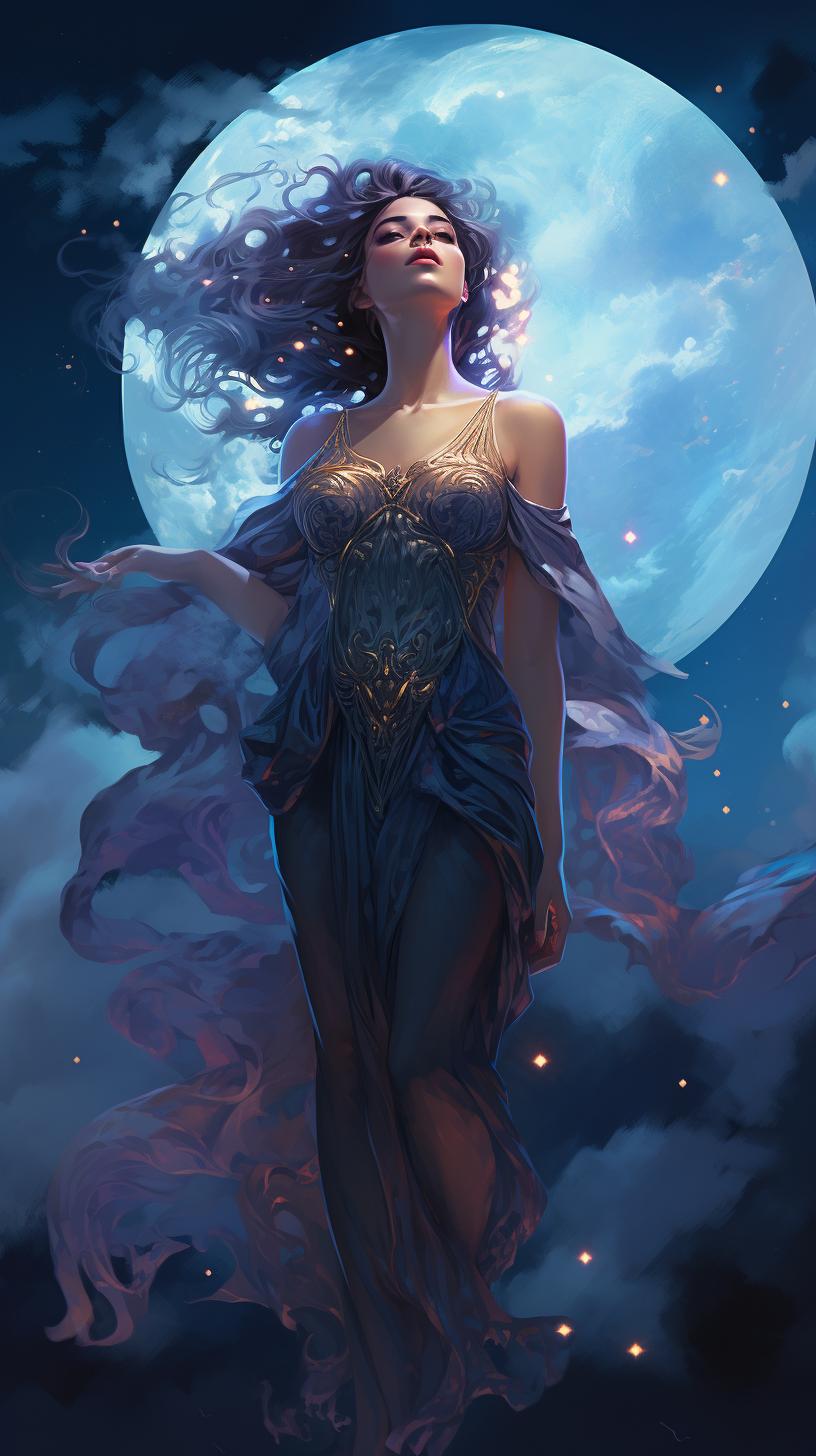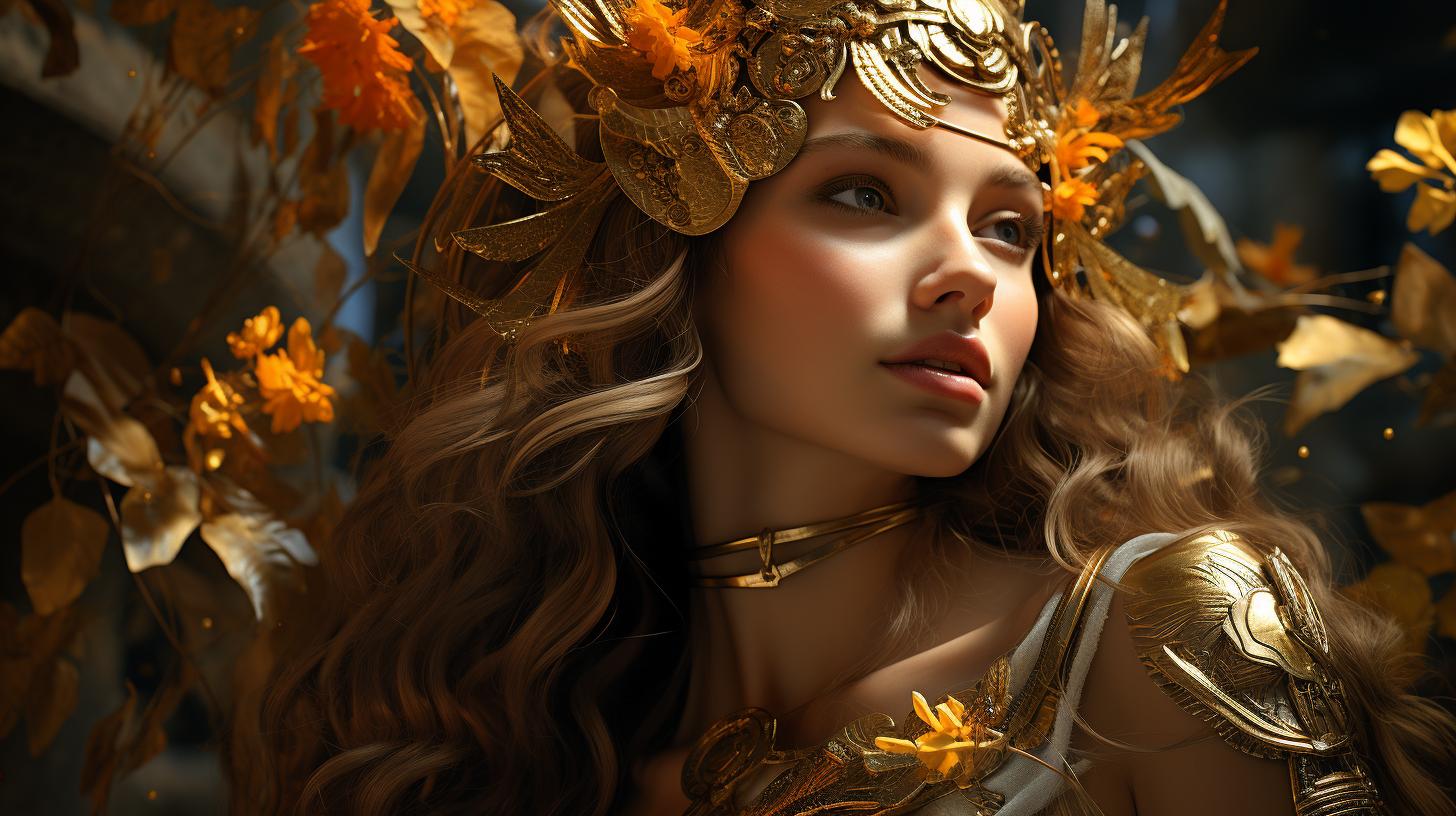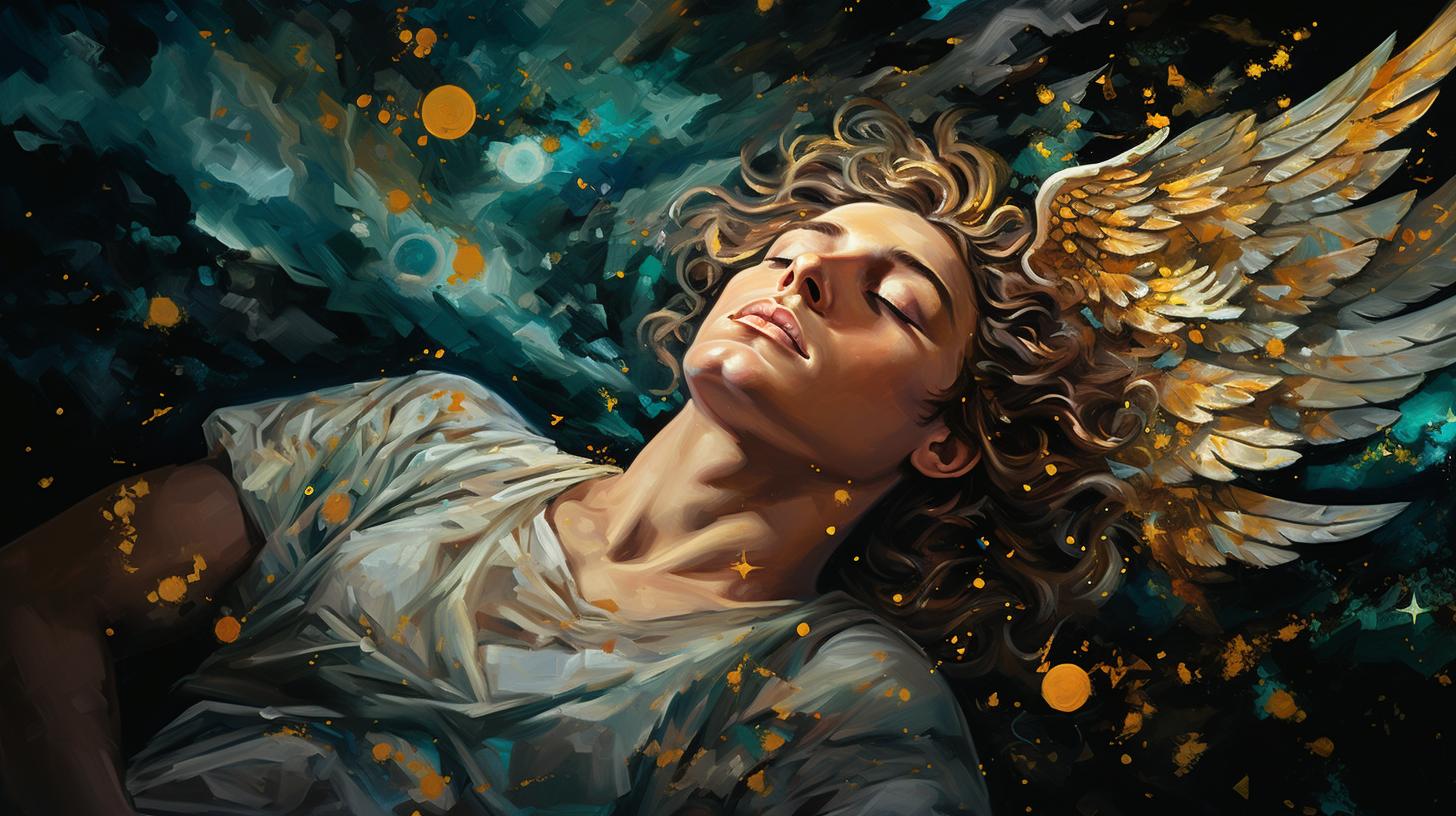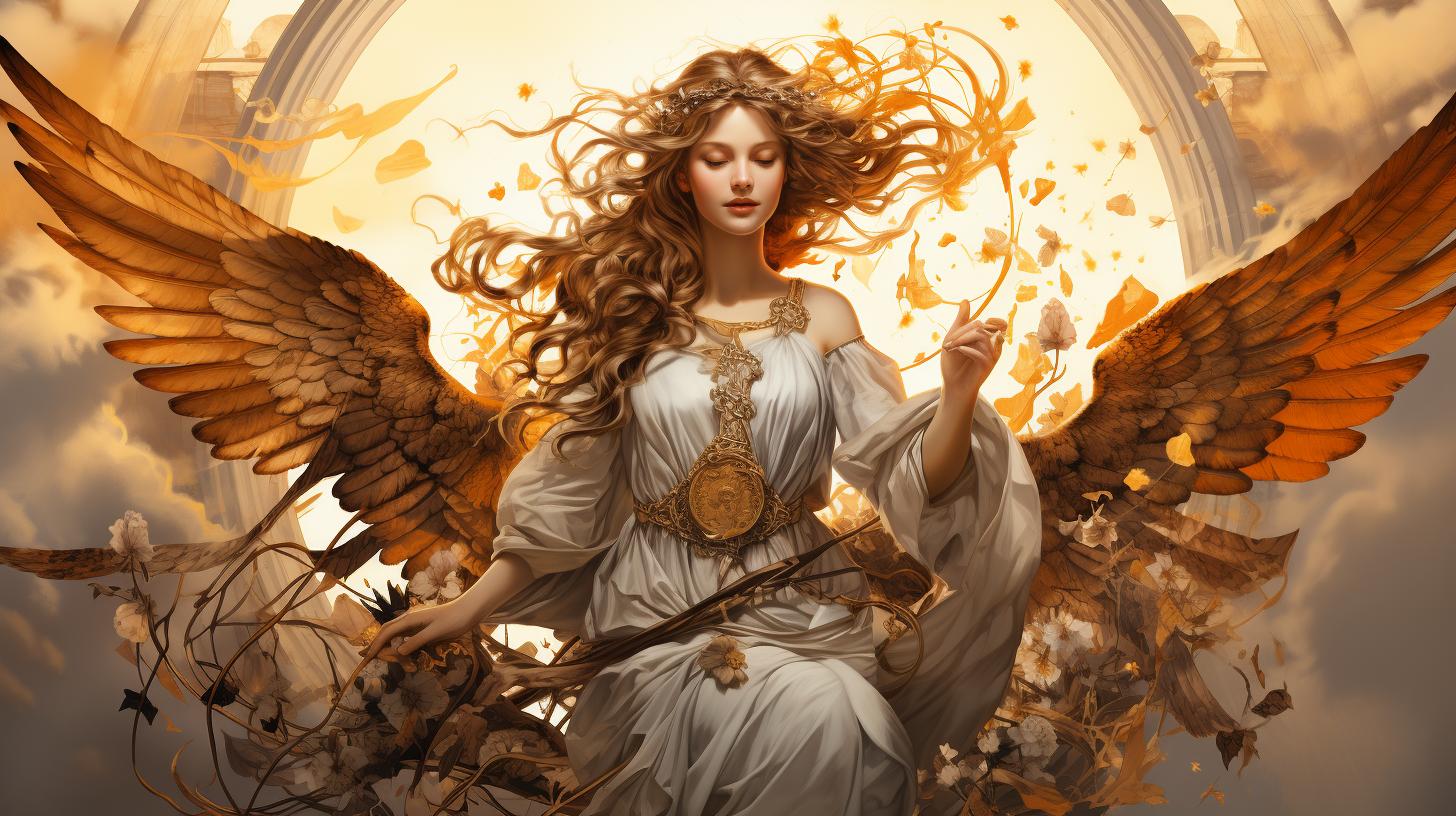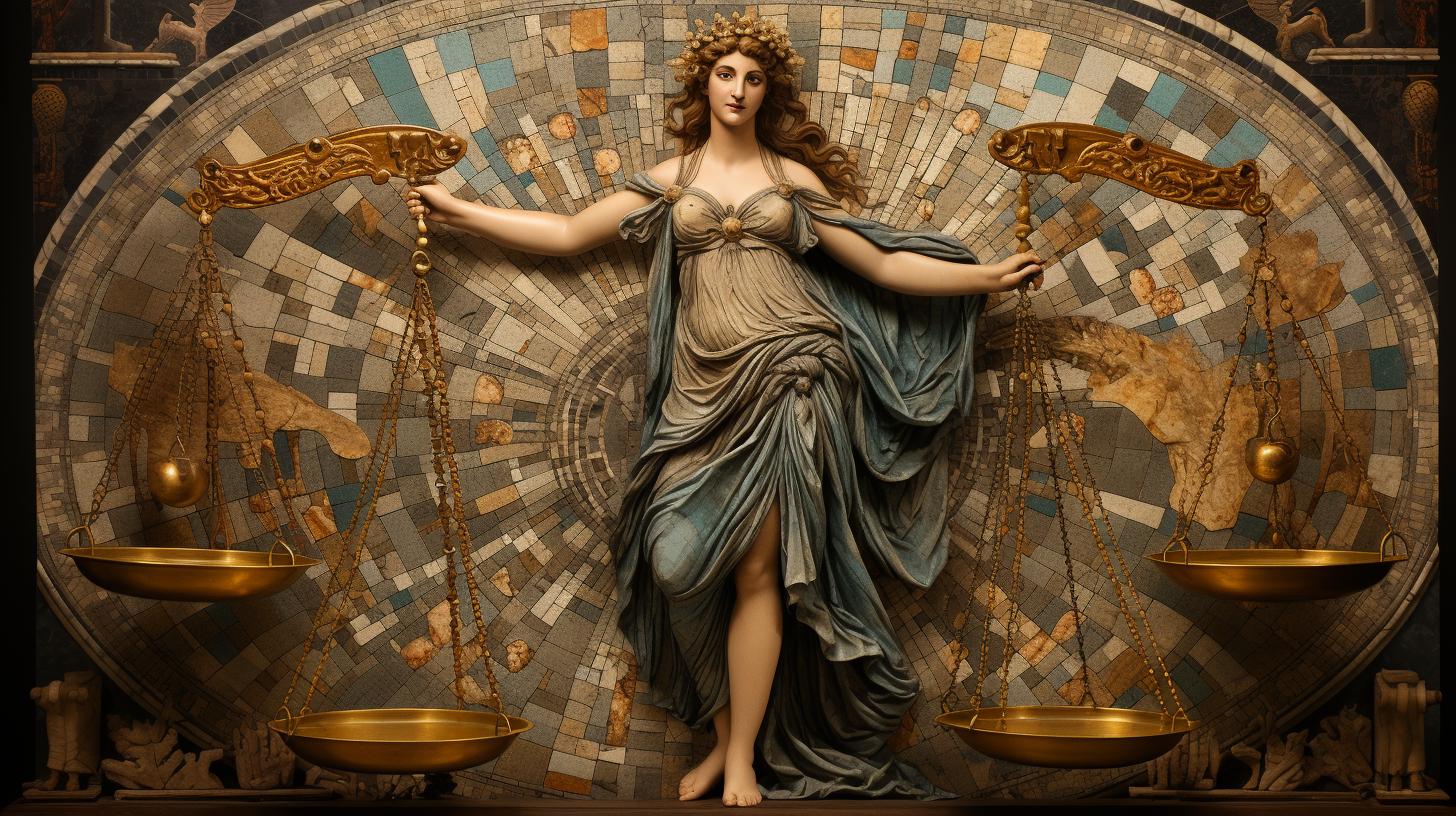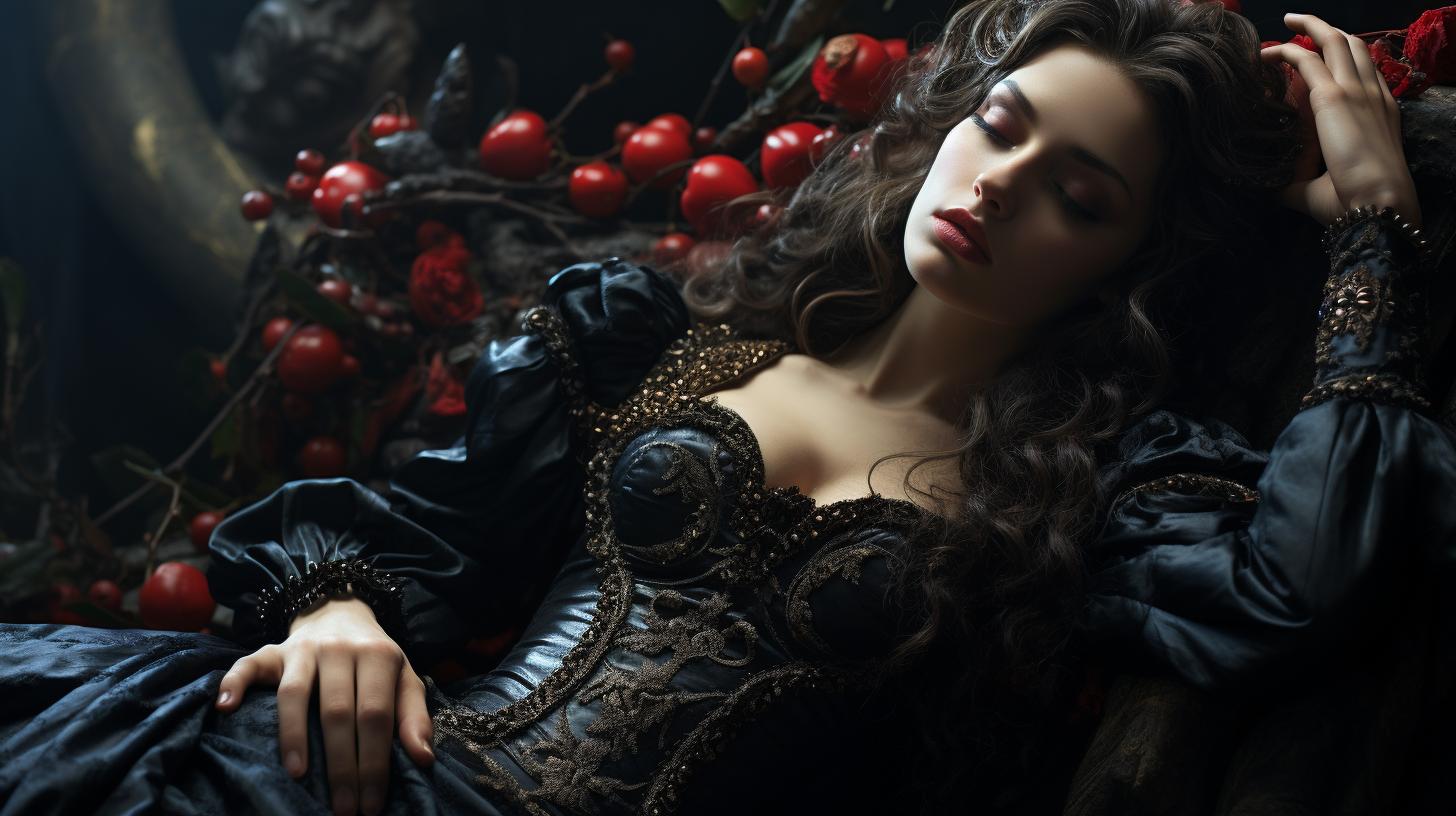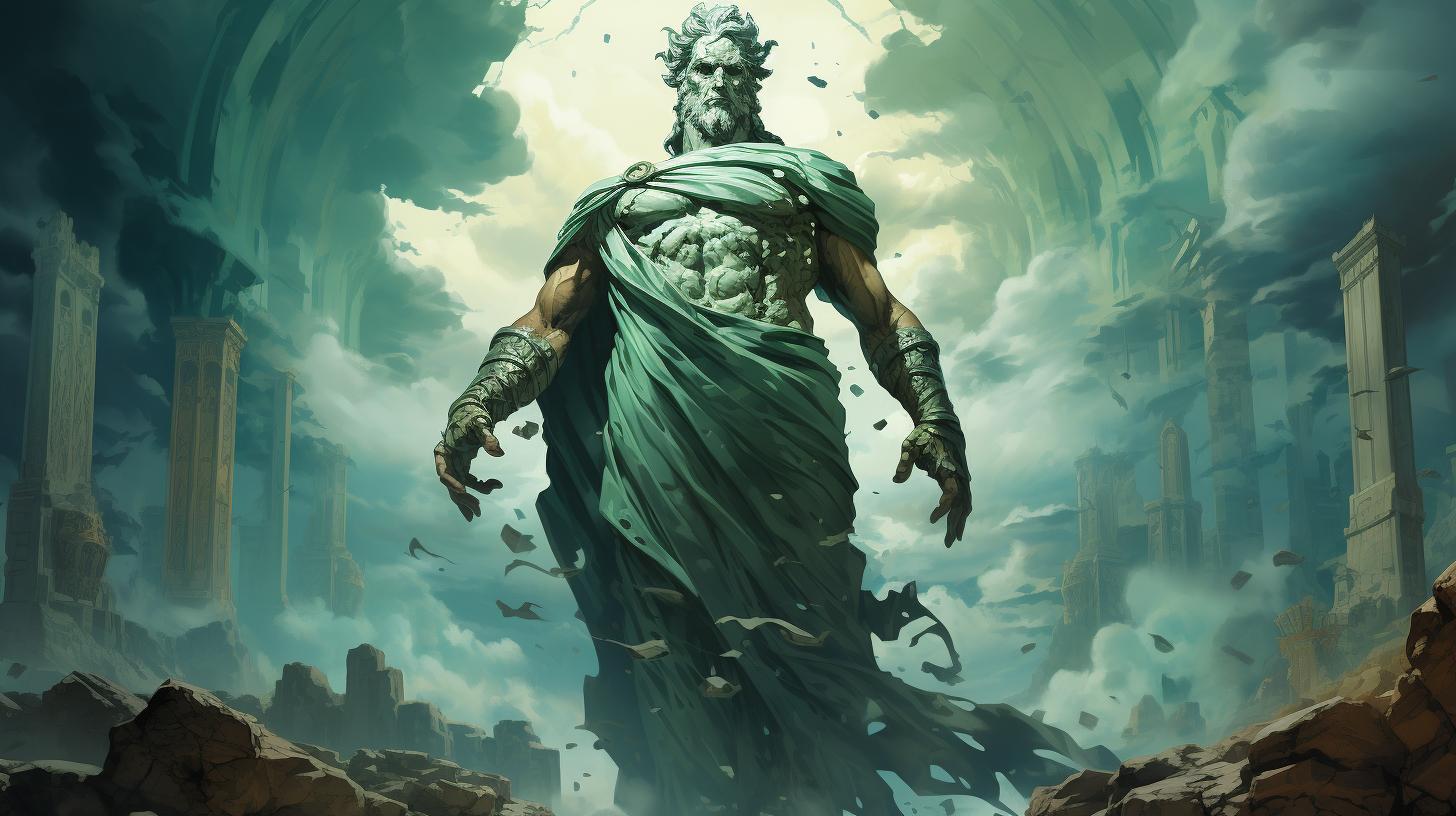Exploring the Roman Goddess Nox: Unveiling the Mysteries of the Night
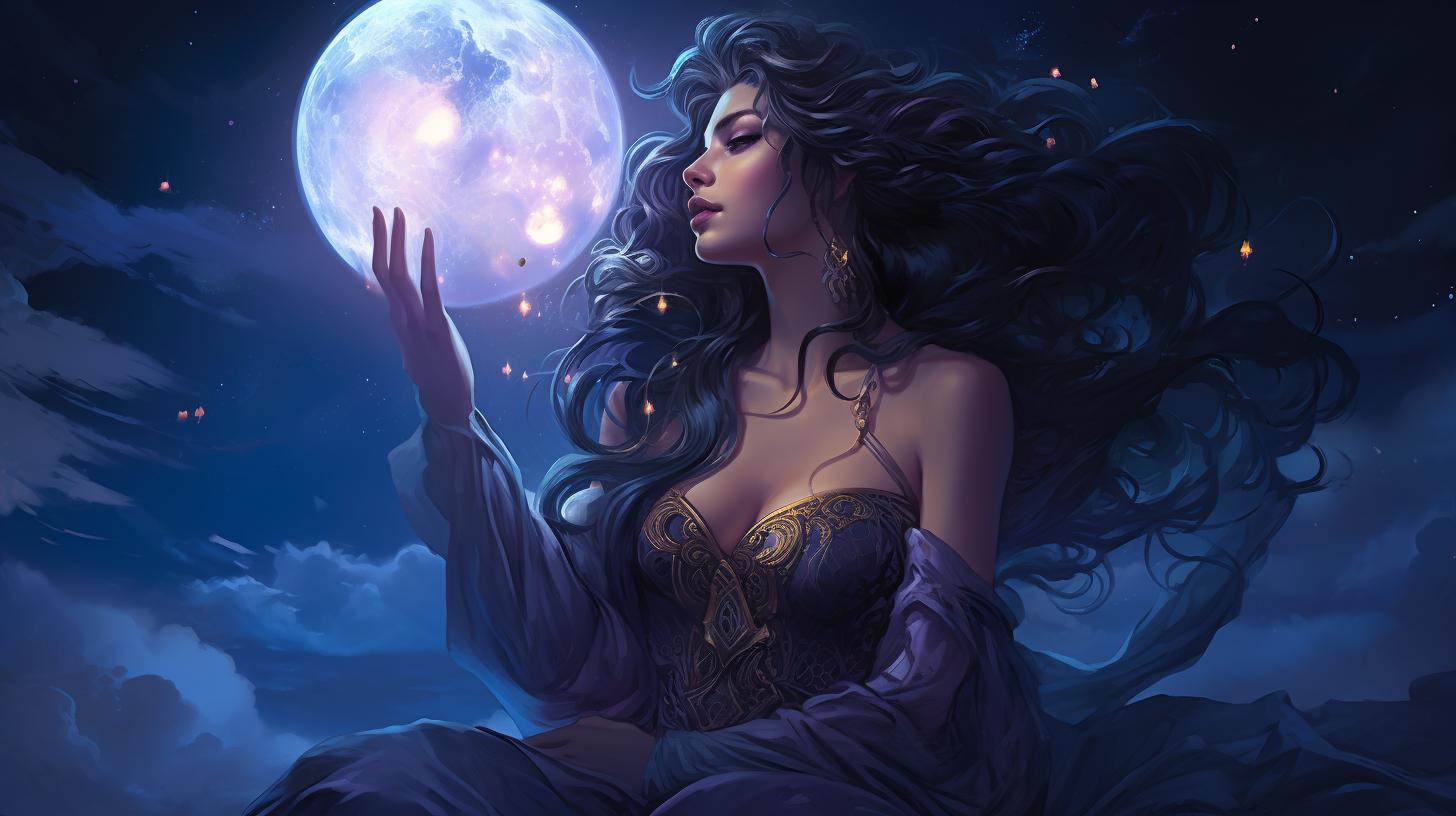
Roman Goddess Nox, known as the counterpart to the Greek deity Nyx, holds a significant place in both Greek and Roman mythology. Nyx is revered as the primordial goddess of the night, daughter of Chaos and mother to various forces of darkness.
Similarly, Nox is recognized as the Roman equivalent, associated with the moon and personifying the night. Both goddesses are depicted with dark attire, surrounded by an aura of mystery. As we delve into their genealogy, roles, and influences, we uncover the captivating tales and profound symbolism surrounding the goddesses of the night.
The Family of Nyx
Exploring the origins and lineage of the Roman goddess Nox begins with delving into the family of Nyx, her Greek counterpart. Nyx holds a prominent place in Greek mythology, weaving a complex web of familial relationships and genealogies.
Nyx and Chaos: A Mythological Lineage
Nyx, the goddess of the night, emerges from the primordial entity known as Chaos. In the mythological lineage, Nyx is the daughter of Chaos, representing the primeval state of the universe.
This connection with Chaos highlights Nyx’s role as a fundamental force in Greek cosmogony.
Nyx’s Children: Exploring the Forces of Darkness
Nyx gives birth to a diverse array of children, each personifying different negative forces and aspects of the night. Among her offspring are Moros (Doom), Ker (Fate), Thanatos (Death), Hypnos (Sleep), and, the collective dream gods known as the Oneiroi.
These primal forces represent the darker aspects of existence, embodying the mysteries and potential dangers of the night.
Nyx in Orphic Tradition: An Alternate Genealogy
In Orphic tradition, Nyx takes on a different genealogy and mythology. She is considered the mother of Uranus, the sky god, and sometimes even the mother of Gaia, the earth goddess.
This alternative genealogy highlights Nyx’s connection to the creation of the cosmos and emphasizes her primordial nature as a foundational deity.
Roman Goddess Nox: An Introduction
The world of Roman mythology offers a captivating glimpse into the ancient beliefs and traditions of the Roman civilization. Among its pantheon of deities, Nox, the Roman counterpart of Nyx, holds a significant place as the goddess of the night.
In this section, we will explore the fascinating realm of Nox, delving into her role in Roman mythology, her relationship with Nyx, and her symbolic representations.
Roman Mythology: A Brief Overview
To truly appreciate the significance of Nox, it is crucial to understand the context of Roman mythology. Roman mythology is a rich tapestry of stories and beliefs woven from various sources, heavily influenced by Greek mythology.
The Romans adapted and assimilated deities from various cultures, creating a unique pantheon that reflected their values, ideals, and daily life.
Nox, the Roman Equivalent of Nyx
In Roman mythology, Nox reigns as the embodiment of the night, parallel to the Greek goddess Nyx. She symbolizes darkness, silence, and the mysteries that unfold under the cover of night.
Although similar in essence, Nox has her distinct attributes and characteristics, reflecting the Roman interpretation of Nyx’s divine essence.
Depicting Nox: Symbols and Representations
The portrayal of Nox in Roman art and literature offers a glimpse into her symbolism and representations. Typically depicted as a veiled figure cloaked in darkness, Nox captures the essence of the night.
Her veiled appearance signifies the secrecy and enigma shrouding the night, and her association with shadows, stars, and the moon adds mystique to her imagery.
Exploring the Night Goddesses: Nyx and Nox
Similarities and Differences in Greek and Roman Mythology
.
In Greek and Roman mythology, the concept of the night goddess is embodied by Nyx and Nox, respectively. Both goddesses are associated with darkness, representing the enigmatic realm of the night.
They share similarities in their roles, symbolism, and divine attributes, but also have distinct characteristics influenced by their respective cultures.
Nyx and Nox: Goddesses of the Night
.
Nyx and Nox hold a significant place in their respective mythologies as the goddesses of the night. Nyx is portrayed as a winged deity with a halo of dark clouds or dressed in black surrounded by mist, while Nox is often depicted wearing a black veil adorned with silver stars.
Their appearance embodies the mysterious and captivating nature of the night, evoking feelings of awe and reverence.
Roles and Powers: Unveiling the Mythological Significance
Nyx’s Role and Powers
Nyx’s role in Greek mythology extends beyond being the personification of the night. As the mother of various gods and abstract concepts, she represents the primordial forces that shape the cosmos.
Nyx holds sway over the dreams of mortals, the secrets of the universe, and the fates of individuals. Her powers evoke both awe and fear, highlighting her significance in the Greek pantheon.
Nox’s Role and Powers
In Roman mythology, Nox assumes a similar role as the goddess of the night. She governs the cycle of darkness and plays a vital role in the balance of the day and night.
Nox’s realm encompasses not only the physical absence of light but also the deeper symbolic meanings associated with the night, such as dreams, mystery, and introspection. Her powers influence various aspects of human existence, reminding mortals of the importance of rest and reflection.
Mythological Significance
The mythological significance of Nyx and Nox lies in their representation of the hidden and unseen aspects of the world. As goddesses of the night, they provide a contrast to the familiar and illuminating realm of daylight.
Both Nyx and Nox symbolize the cyclical nature of existence, reminding us of the constant interplay of light and darkness, and the inherent balance found within the cosmos.
- The night, personified by Nyx and Nox, serves as a canvas for dreams, contemplation, and self-reflection.
- Their deep association with darkness emphasizes the power of unseen forces and the mysteries of the universe.
- As nurturing and protective goddesses, Nyx and Nox remind humans of the importance of rest, rejuvenation, and introspection.
- Nyx and Nox’s mythological significance lies in their ability to unveil the hidden aspects of life and guide individuals through the transformative journey of the night.
In exploring the night goddesses, Nyx and Nox, we encounter the rich tapestry of ancient Greek and Roman mythology.
Their similarities and differences offer insight into the diverse cultural interpretations of the night’s profound mysteries and symbolic significance. These divine beings continue to captivate our imagination, inspiring a deeper understanding of the hidden realms that exist within and beyond the veil of darkness.
Nyx/Nox in Hesiod’s Theogony
Nyx’s presence and significance in Greek mythology can be traced back to the ancient epic poem “Theogony” authored by Hesiod. In this influential work, Hesiod provides valuable insights into Nyx’s lineage, her notable offspring, and her profound influence on the realm of Greek mythology.
Nyx’s Lineage according to Hesiod
According to Hesiod, Nyx is born from Chaos, the primordial void, making her one of the earliest divine entities. As the daughter of Chaos, she holds a significant position within the divine hierarchy.
This lineage emphasizes Nyx’s primordial nature and emphasizes her role as a fundamental force in the cosmos.
Nyx’s Children and their Significance
Nyx is the mother of various powerful and significant entities in Greek mythology. Among her notable offspring are Moros (Doom), Ker (Fate), Thanatos (Death), Hypnos (Sleep), and the Oneiroi (Dreams). Each of these children personifies forces and phenomena associated with darkness, sleep, and death, highlighting Nyx’s dominion over these realms.
Their existence and actions play significant roles in shaping the narratives of various Greek myths.
Examining Nyx’s Influence on Greek Mythology
Nyx’s influence extends beyond her own lineage, as she often plays a crucial role in other mythological narratives. Her presence can be felt in stories involving gods and heroes, where she weaves her dark influence into the fabric of destiny, shaping the outcomes of events.
Nyx’s power and influence over the night give her a unique position in Greek mythology, highlighting the significance of her role in the grand tapestry of divine beings.
Nox in Roman Mythology: Goddess of Night
Nox holds a significant position in Roman mythology as the goddess of the night. She is revered and associated with darkness, and her influence permeates various aspects of Roman culture. Let’s delve deeper into Nox’s role in Roman mythology, exploring her offspring, powers and attributes, as well as her significance in society and culture.
Nox’s Offspring: Exploring the Roman Pantheon
Nox, as a prominent goddess, gives rise to a multitude of offspring within the Roman pantheon. Among her notable children are Aether, Dies, and numerous other beings embodying different aspects of darkness and nocturnal forces.
These divine entities, including Amor, Dolus, Metus, Mors, and the Parcae, each contribute to the intricate web of Roman mythology, further emphasizing Nox’s influence as the goddess of the night.
Nox’s Powers and Attributes: A Closer Look
Nox possesses a range of powers and attributes closely tied to her dominion over the night. As the embodiment of darkness, she wields formidable control over nocturnal phenomena. Nox is believed to have influence over dreams, disease, suffering, and even death itself.
Her association with the moon symbolizes her connection to the cycles of night and provides her with additional powers. By understanding Nox’s distinct abilities, we gain insight into her significance and the reverence she commands in Roman mythology.
Nox’s Role in Roman Society and Culture
In Roman society, Nox plays a crucial role in the spiritual and cultural fabric. Her association with night and the celestial bodies grants her relevance in religious rituals and festivals, wherein nocturnal worship and offerings are made to appease her and seek her blessings.
Nox’s influence permeates Roman literature, art, and music, as her enigmatic nature captivates the imagination of poets, sculptors, and musicians alike. The enduring legacy of Nox in contemporary culture speaks to the enduring fascination with this goddess of the night.
In conclusion, Nox’s significance in Roman mythology as the goddess of the night is an integral part of the belief system and cultural identity of ancient Rome. Her offspring, powers, and role in society further solidify her position as a powerful and influential deity.
Exploring the depths of Nox’s mythology sheds light on the reverence and fascination associated with the enigmatic concept of the night.
Nyx/Nox in Ancient Epics: The Iliad and Orphic Tradition
Nyx, the primordial goddess of night, has a significant presence in ancient epics such as the Iliad and the Orphic tradition. These texts provide insights into her roles, interactions, and primordial nature, as well as comparisons between the depictions of Nyx and her Roman counterpart, Nox.
Nyx’s Role and Interactions in the Iliad
In the Iliad, Nyx plays a crucial role in saving Hypnos, the god of sleep, from the wrath of Zeus. She intervenes to protect Hypnos, highlighting her power and influence even among the highest ranks of the Olympian gods.
Nyx’s actions showcase her protective nature as the personification of night, ensuring the smooth running of the divine order.
Nyx in Orphic Tradition: Insights into Her Primordial Nature
In the Orphic tradition, Nyx holds a prominent position as the first existing being. She is revered as the queen of gods and the nurturer of deities. As the primordial goddess, Nyx symbolizes the mysterious and everlasting nature of night and darkness.
Her ability to bring forth an “egg of wind” from which Eros emerges represents her connection to creation.
Comparing the Depictions of Nyx/Nox across Texts
When examining the depictions of Nyx and her Roman counterpart Nox across various texts, similarities and differences arise. Both goddesses represent the primordial forces of night and darkness, but their specific attributes and genealogies vary.
Nyx is often portrayed as a winged goddess surrounded by dark mist, whereas Nox is associated with the moon and depicted wearing a black veil adorned with silver stars.
- In the Iliad, Nyx’s role is more limited, emphasizing her protective nature and her ability to intervene in the affairs of the gods.
- In the Orphic tradition, Nyx inherits a more prominent position as the first and most mighty goddess.
- Nox, as the Roman equivalent of Nyx, shares similar associations with night and darkness but is also linked to lunar imagery and the day of the week known as Monday.
- While there are variations in their genealogies, both Nyx and Nox are considered mothers to a wide range of significant deities, personifications, and forces.
The depictions of Nyx and Nox across texts highlight the enduring fascination with these goddesses and their roles in mythology.
Exploring their complexities and symbolism enriches our understanding of the profound impact of night and darkness in ancient epics.
Unveiling the Secrets of Greek/Roman Night Goddess Worship
The worship of the Greek and Roman night goddesses, Nyx and Nox, held a significant place in ancient cultures. From elaborate rituals to festive celebrations, devotees honored these enigmatic deities in various ways.
Let’s delve into the secrets surrounding Greek/Roman night goddess worship, exploring the cultural significance, ancient rituals, and the enduring influence of Nyx/Nox in contemporary society.
Ancient Rituals and Festivals Dedicated to Nyx/Nox
Ancient civilizations recognized the importance of Nyx/Nox and paid homage to these powerful night goddesses through elaborate rituals and festivals. The Nyctelia, an annual festival held in Athens, involved sacred ceremonies, processions, and offerings presented to Nyx.
Participants would gather at temples dedicated to the goddesses, engaging in solemn prayers and performing nocturnal rites to seek their blessings.
In Rome, the festival known as Dies Noctis (Day of Night) celebrated Nox’s divine influence. This event consisted of nighttime processions, where worshippers dressed in black and carried torches, symbolizing the illumination of the darkness.
Offerings such as wine, dark-colored fruits, and incense were presented to Nox as devotees sought her guidance and protection.
Understanding the Cultural Significance of Night Worship
Night worship held profound cultural significance in ancient Greek and Roman societies. Nyx/Nox represented the mysterious and often fearful aspects of darkness, embodying the unknown depths of the night. Devotees believed that by paying homage to these goddesses, they could gain protection from nightmares, invoke peaceful sleep, and establish a connection with the hidden realms of dreams and prophecies.
Furthermore, night worship reflected the cyclical nature of life and death, as night symbolized the end of one day and the beginning of the next. It emphasized the importance of embracing both light and dark aspects of existence.
Night rituals created a sense of balance, allowing individuals to acknowledge and honor the omnipresence of Nyx/Nox in daily life.
Legacy and Influence: Nyx/Nox in Contemporary Society
The influence of Nyx/Nox extends far beyond the realms of ancient mythology, resonating in contemporary society. Their enigmatic symbolism continues to captivate artists, writers, and musicians, inspiring numerous creative works. References to Nyx/Nox can be found in literature, where the night is often personified and explored for its mystical qualities.
Moreover, the enduring presence of night rituals in cultural practices around the world reflects the lasting legacy of Nyx/Nox. From modern-day paganism to neo-pagan movements, individuals continue to embrace nighttime spirituality, connecting with the energy and symbolism associated with these revered night goddesses.
The influence of Nyx/Nox on our perception of darkness, dreams, and the cyclical nature of life resonates even in our contemporary understanding and appreciation of the night.
Aether and Hemera: The Children of Nyx/Nox
Aether and Hemera, the children of Nyx/Nox, hold significant roles in Greek and Roman mythology. They represent the forces of light and day, serving as a contrast to their mother’s realm of darkness and night.
Exploring the Roles and Attributes of Aether
Aether embodies the celestial light and the upper atmosphere, bringing clarity and brightness to the world. He is associated with the pure air that the gods breathe and symbolizes the eternal, shining essence of the heavens.
Aether is often depicted as a radiant figure, enveloped in golden light.
As the personification of the upper atmosphere, Aether plays a crucial role in maintaining the order of the cosmos. He is responsible for ensuring the smooth flow of the celestial bodies, enabling the movement of the sun, moon, and stars.
Aether‘s presence brings illumination, enlightenment, and the divine essence to both gods and mortals.
Hemera: Goddess of Day and Nyx’s Counterpart
Hemera, the goddess of day, stands as the counterpart to her mother Nyx/Nox. As Nyx rules over the night, Hemera governs the realm of daylight, symbolizing the everlasting cycle of light and darkness.
She represents the vibrant and active aspect of existence, offering clarity and visibility to the world.
Hemera is often depicted as a radiant figure, adorned with a crown of shining rays. Her presence heralds the beginning of a new day, bringing renewed energy and vitality. She governs the diurnal activities of gods and mortals, ensuring the passage from darkness to light and the harmony of life.
The Siblings’ Relationship and Their Place in Mythology
Aether and Hemera share a close relationship as siblings, embodying the dualistic nature of the cosmos. Together, they bring balance and harmony to the world, acting as cosmic forces that alternate between day and night, light and darkness.
Their roles as children of Nyx/Nox connect them to the broader pantheon of deities, influencing the overall mythology and shaping the understanding of the natural order. As embodiments of light and day, Aether and Hemera provide a counterbalance to the dominion of their mother, shaping the continuous cycle of existence.
Aether and Hemera‘s significance extends beyond their familial ties, contributing to the larger tapestry of Greek and Roman mythology. Their attributes and roles add depth and complexity to the celestial realms, showcasing the interplay between light and darkness, day and night, in the intricate mythology of Nyx/Nox and her progeny.
Eros, Uranus, and Other Offspring: Nyx/Nox’s Extended Family
The night goddess Nyx, known as Nox in Roman mythology, is not only the mother of darkness but also had a diverse array of offspring. These children played significant roles in mythological narratives, each contributing to the rich tapestry of Greek and Roman lore.
Shedding Light on Eros: Love and Desire in Mythology
Eros, the god of love and desire, holds a prominent place among Nyx/Nox’s children. Often depicted as a young winged boy, Eros represents the passionate and sometimes irrational emotions that drive human behavior.
His arrows have the power to ignite feelings of love, lust, and desire, creating profound connections between mortal and immortal beings.
The Primordial Role of Uranus: God of the Sky
Uranus, another notable child of Nyx/Nox, assumes the role of the primordial god of the sky. He is often depicted as a celestial figure, reigning over the vast expanse above. Uranus facilitates the cycle of day and night, providing light and warmth during the day while retreating into the darkness to allow Nyx’s nocturnal reign.
Lesser-Known Children and Their Significance
- Moros: Personification of doom and fate.
- Thanatos: Represents death and mortality, guiding souls to the afterlife.
- Hypnos: The god of sleep, sibling to Thanatos, guiding mortals into the world of dreams.
- Momus: The embodiment of satire, mockery, and criticism.
- Oizys: Symbolizes the distress and misery experienced by mortals.
These lesser-known children of Nyx/Nox delve into the darker aspects of the human experience.
Moros and Oizys exemplify the inevitability of doom and the anguish that accompanies it. Thanatos and Hypnos present the intricacies of mortality, the journey that lies beyond life, and the realm of dreams.
Lastly, Momus offers a critical lens through which to view the human condition, encouraging introspection and growth.
As part of Nyx/Nox’s extended family, each of these children contributes to the complex and multifaceted nature of the night goddess and her Roman counterpart. Their stories and attributes intertwine with those of other deities, weaving an intricate web of mythology that spans generations and captures the essence of the human experience.
The Hesperides and Moirai: Guardians of the Night
A crucial aspect of the mythological realm surrounding the Roman goddess Nox pertains to the guardianship of the night. Within this realm, two influential groups emerge: the Hesperides and the Moirai.
These entities play distinct roles in the dominion of darkness, each holding unique responsibilities and wielding significant influence over the course of events.
Understanding the Hesperides: Nymphs of the Evening
The Hesperides are a trio of nymphs who preside over the evening, embodying the beauty and serenity that accompanies dusk. As daughters of Nyx/Nox, they are entrusted with guarding the fabled Garden of the Hesperides, a place of exquisite tranquility and abundance.
- Keepers of Divine Fruit: The primary role of the Hesperides is to tend to the magical trees within their garden, bearing precious golden apples. These apples are believed to confer immortality upon those who consume them.
- Associations with Precious Metals: The Hesperides are often depicted surrounded by shimmering light and adorned with gleaming jewelry, symbolizing their connection to riches and wealth.
- Protectors of Twilight: As custodians of the transition between day and night, the Hesperides ensure the smooth passage from daylight to darkness, maintaining the delicate balance between light and dark.
Delving into the Role of the Moirai: Goddesses of Fate
The Moirai, also known as the Fates, emerge as prominent figures in the mythological fabric related to Nyx/Nox.
As three powerful sisters, they govern the destinies of mortals, weaving the intricate tapestry of each individual’s life.
- Weavers of Fate: The Moirai control the threads of life, determining the destiny of every being. Clotho spins the thread, Lachesis measures its length, and Atropos, the eldest and most formidable, severs it, signifying the end of life.
- Fate and Divination: Revered as oracles, the Moirai possess knowledge of past, present, and future events.
Their prophecies guide the paths of mortal beings, shaping the course of history.
- Immutable Decisions: The pronouncements and actions of the Moirai are absolute and beyond challenge. They are considered the ultimate arbiters, their decisions binding and irreversible.
Nyx/Nox’s Influence on the Hesperides and Moirai
Being the mother figure of both the Hesperides and the Moirai, Nyx/Nox exerts a powerful influence over their existence and roles in mythology.
- Power Infused by Darkness: Nyx/Nox’s association with darkness and the night grants the Hesperides and the Moirai their inherent power over the twilight hours and the weaving of destiny.
- The Connection to Immortality: As daughters of Nyx/Nox, the Hesperides guard the golden apples that are said to grant everlasting life, directly tying them to the eternal nature of their mother.
- Fate Embedded in Darkness: The Moirai, guided by Nyx/Nox’s primordial knowledge, possess the ability to shape the future and dictate the fortunes of mortals, their powers derived from the depth of night.
Hypnos and Thanatos: The Brothers of Sleep and Death
The realm of Nyx/Nox extends beyond the darkness of night, as it includes two powerful deities: Hypnos and Thanatos.
These brothers play essential roles in the Greek and Roman mythologies, representing sleep and death, respectively. Let’s delve into their individual characteristics and explore the intriguing connections they share with Nyx/Nox.
Hypnos: The God of Sleep and Dreams
Hypnos, son of Nyx/Nox, reigns over the realm of dreams and tranquility. He possesses the power to grant restful sleep to both mortals and gods, with his touch inducing peaceful slumber.
Depicted as a gentle and serene deity, Hypnos is often seen adorned with wings, symbolizing his ability to swiftly descend upon weary souls. He holds a crucial place in Greek mythology, as his influence extends even to the mighty gods.
Thanatos: Personification of Death and Mortality
On the opposite end of the spectrum, we find Thanatos, the personification of death and mortality. As Nyx/Nox’s son, Thanatos is the harbinger of the end, guiding souls to the afterlife.
He is portrayed as a solemn figure, often wielding a sword or accompanied by his siblings – the Keres, representing violent deaths. Despite his somber nature, Thanatos is an integral part of the cycle of life and carries out his duty with unwavering determination.
Exploring the Connections between Hypnos, Thanatos, and Nyx/Nox
Both Hypnos and Thanatos have strong ties to their mother Nyx/Nox, drawing power and authority from their shared lineage. While Hypnos is more closely associated with sleep, dreams, and tranquility, Thanatos embodies the inevitable passage into the realm of death.
Their interconnected existence reflects the delicate balance between restful sleep and the eventual end that awaits all living beings. As siblings and extensions of the primordial night goddess, Hypnos and Thanatos serve as vital components in the grand tapestry of Greek and Roman mythology.
Myths and Legends Associated with Nyx/Nox
Myths and legends surrounding the Roman goddess Nox (equivalent to the Greek goddess Nyx) delve into fascinating tales that captivate the imagination. These stories highlight the significance of night and darkness in ancient mythology, revealing the depths of Nyx/Nox’s influence and power.
The Legends of the Oneiroi: The Dream Gods
Among the intriguing myths associated with Nyx/Nox are those centered around the Oneiroi, the gods of dreams. Born from Nyx/Nox’s own darkness, the Oneiroi bring forth dreams to mortals as messengers from the realm of sleep.
These dreams possess the ability to foretell the future, reveal hidden truths, or convey divine messages. The tales of the Oneiroi offer glimpses into the mysterious realm of dreams and their significance in the ancient world.
Nyx/Nox’s Deities of Retribution: The Keres and Erinias
Nox/Nyx is also linked to the Keres and Erinias, deities associated with retribution and vengeance. The Keres, personifications of violent death, are believed to be born from Nyx/Nox’s blood. They embody the dark forces that accompany war and conflict, instilling fear and panic on the battlefield.
The Erinias, or Furies, are avenging goddesses who punish wrongdoers and enforce divine justice. These mythological figures represent the power of Nyx/Nox to bring about justice and retribution in the ancient world.
Unraveling Tales of Nyx/Nox’s Children in Mythology
The offspring of Nyx/Nox play significant roles in ancient mythology, each carrying their own symbolic meanings. From Eros, the god of love and desire, to Thanatos, the personification of death, their stories intertwine with the fundamental elements of life.
These tales shed light on the intricate connections between Nyx/Nox and their children, showcasing the vast range of influences that night and darkness have in mythology.
Beyond Greek and Roman Mythology: Nyx/Nox in Contemporary Culture
References to Nyx/Nox in Literature, Art, and Music
Nyx and Nox, the captivating goddesses of the night, have left an enduring mark on various forms of artistic expression. In literature, their mystique and darkness have inspired numerous authors to incorporate their essence into their works.
From the atmospheric descriptions of nocturnal scenes to the exploration of themes related to darkness and mystery, Nyx and Nox’s influence is evident. Esteemed writers like Edgar Allan Poe and H.P
.
.
Lovecraft have explored the depths of the night, drawing inspiration from these ancient deities. In the world of art, the distinct imagery associated with Nyx and Nox has fascinated painters, sculptors, and illustrators throughout the centuries.
The contrasting interplay of black and silver, symbolizing the night sky, serves as a prominent motif in their representations. Artists often depict them with ethereal beauty, evoking a sense of both awe and fear.
Their presence in visual arts adds an enchanting and enigmatic dimension, capturing the fascination with the night in various cultures. The realm of music also embraces the allure of Nyx and Nox.
From classical compositions to contemporary popular songs, their nocturnal realm acts as a source of inspiration. Musicians explore the themes of darkness, moonlight, and the mystical qualities associated with nighttime through their melodic creations.
The atmospheric soundscapes and haunting melodies pay homage to the goddesses, giving listeners a glimpse into the captivating world of Nyx and Nox.
Nyx/Nox’s Influence in Popular Culture and Entertainment
Beyond traditional art forms, Nyx and Nox’s influence extends into the realm of popular culture and entertainment. In contemporary literature, their names and characteristics continue to appear, not only as direct references but also as themes that explore the duality of darkness and light.
These goddesses serve as archetypes representing the hidden aspects of human nature, adding depth and complexity to characters and storylines. Film and television have also drawn inspiration from Nyx and Nox, incorporating their symbolism and themes into various productions.
The portrayal of the night, accompanied by atmospheric visuals and storytelling, captures the mystery and allure associated with these deities. Whether as central characters or as elements woven into the narrative, Nyx and Nox contribute to the creation of immersive and atmospheric storytelling experiences.
Exploring the Enduring Legacy of the Night Goddesses
The legacy of Nyx and Nox continues to leave an indelible mark on contemporary society. Their enduring presence in art, literature, music, and entertainment reflects humanity’s ongoing fascination with the night and the mysteries it holds.
As symbols of darkness and the primal forces of the universe, these goddesses embody the timeless aspects of the human experience. The allure of Nyx and Nox’s realm transcends time and cultural boundaries, resonating with people seeking a deeper understanding of the mysteries that lie within and beyond the darkness.
Their enduring legacy serves as a reminder of the intricate web of mythology and its profound influence on the human psyche. As we navigate the modern world, Nyx and Nox’s presence reminds us of the inherent beauty and enigma of the night, encouraging us to embrace the darkness within ourselves and explore the depths of our own existence.
- References to Nyx/Nox in Literature, Art, and Music
- Nyx/Nox’s Influence in Popular Culture and Entertainment
- Exploring the Enduring Legacy of the Night Goddesses
….

